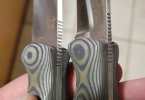I like the added grip that jimping provides but I noticed often times my thumb is further back and still on the handle. Jimping, at least on my knives, doesn't exist here, only forward of the handle. Is it possible to jimp slightly into the handle? Maybe cut them into the blade pre HT where it feels best, then follow that into the handle to re-expose after glue up? Do I have my head up my BEEP again and can't see the glaring dilemma?
-
The BladeForums.com 2024 Traditional Knife is available! Price is $250 ea (shipped within CONUS).
Order here: https://www.bladeforums.com/help/2024-traditional/
You are using an out of date browser. It may not display this or other websites correctly.
You should upgrade or use an alternative browser.
You should upgrade or use an alternative browser.
Jimping near and into the handle
- Thread starter GRapp
- Start date
Richard338
Gold Member
- Joined
- May 3, 2005
- Messages
- 7,409
You can jimp wherever you like. I've put it partly in the scales before and you should see many examples out there.
- Joined
- Mar 4, 2013
- Messages
- 3,157
I am working on a few that I have exactly this. On the handle I round the section where my index finger lands in a forward grip, then serrate with a 30LPI checkering file. When I mount the scales, I cut that area of the scale back to where the rounding meets the flat. After glue up, carefully shape the scales and remove the glue from the serrations.
- Joined
- Jan 9, 2011
- Messages
- 16,397
Yes, do pre heat treat and break the edge a bit (round/chamfer the spine and jimping just a hair) so it is rounded to avoid stress risers. You can use a tumbler for this, scotchbrite wheel, buffer, file, sandpaper, whatever is handy.
A.McPherson
Knifemaker / Craftsman / Service Provider
- Joined
- Jan 27, 2012
- Messages
- 2,909
Gimping?
:-D
:-D
- Joined
- Dec 5, 2005
- Messages
- 28,373
oops!Gimping?
:-D
thought this was one of those W&C gimping threads
- Joined
- Dec 5, 2005
- Messages
- 28,373
but seriously tho

Terzuola has a big influence on my work, and he's one of the makers who regularly used jimping along the tang without adding it to the scales.
A few things I learned about doing this
-yes it needs to be done prior to heat treatment, and it needs to be cleaned up after- especially if you're unlucky enough to get decarb in your jimps
-epoxy will find its way into the valleys upon glue up so you need to get that stuff outta there before it cures, so it's important to cut your scales close enough to the tang that you can reach in there
-it helps to use compressed air to blow some of the epoxy out
-you don't want to use a solvent- there is too much potential for the solvent to work its way in, so pretty clean is clean enough
-once cured, a metal pick can be used to clean out the last of the epoxy once the handle is completely finished. Magnification helps a ton

Terzuola has a big influence on my work, and he's one of the makers who regularly used jimping along the tang without adding it to the scales.
A few things I learned about doing this
-yes it needs to be done prior to heat treatment, and it needs to be cleaned up after- especially if you're unlucky enough to get decarb in your jimps
-epoxy will find its way into the valleys upon glue up so you need to get that stuff outta there before it cures, so it's important to cut your scales close enough to the tang that you can reach in there
-it helps to use compressed air to blow some of the epoxy out
-you don't want to use a solvent- there is too much potential for the solvent to work its way in, so pretty clean is clean enough
-once cured, a metal pick can be used to clean out the last of the epoxy once the handle is completely finished. Magnification helps a ton

